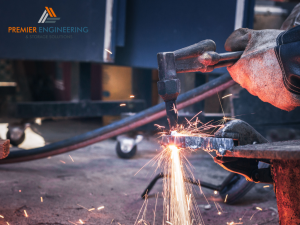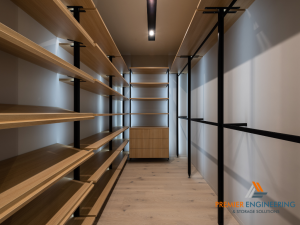For warehouse owners, safety isn’t just a matter of looking good to potential clients. The costs associated with a warehouse pallet rack accident can be incredibly high, and while various forms of insurance can cover some of the costs, some will be the employer’s burden to bear.
Even if the accident wasn’t management’s fault, the paperwork and resulting lost time can be burdensome. Since you can’t always control your employees’ actions, the best way to prevent accidents is to make your infrastructure as safe as possible.
However, training of employees is still critical, as there is no way to make a warehouse or factory completely free of hazards. In addition to following best practices and general shelving guidelines , take care to proactively protect shelving from damage and monitor any slight damage or leaning that occurs over time.
Inspect Up-Close
Rust, missing safety clips and bolts, bending shelves, and other seemingly minor damage can have serious consequences. Even if your shelves are relatively new, take the time to inspect them once every few months.
Make sure also to inspect stairs and ladders, including their wheels, as these can be damaged just through everyday use. Also, make sure to re-inspect shelving units after every accident, no matter how minor.
A forklift collision with a corner of the shelving unit can cause safety clips to become dislodged in another corner. If possible, have a supervisor or manager do a brief walk-through inspection of shelving once per day. This will hopefully allow leadership to catch and deal with any damage from unreported forklift accidents or other mishaps.
Do a more thorough inspection, with a flashlight and level in hand to inspect potential damage, every few months or after any event that could have caused damage.
Measure Leaning Shelves
You can usually figure out if a shelf is leaning by holding up a level to various vertical sections of it. If one or more of the sections you measure isn’t vertical, you will need to determine just how much the shelf is tilting. A shelving professional can help you make those measurements correctly.
Based on these strict guidelines, a shelving unit must be unloaded and re-plumbed if its out-of-plumb ratio exceeds 1:240. In other words, if a 10-foot-high rack is leaning more than half an inch, it needs to be straightened or replaced.
Ideally, have a professional measure plumbness every few months, and schedule a re-measurement sooner if a shelf starts to lean more than a quarter of an inch. If you are certain that you or another manager has the skills to measure shelf plumbness correctly, then it can be done in-house.
Make sure to take detailed notes on which shelves were measure from which angles. While this can be a hassle, it’s far better than dealing with problems associated with a pallet accident.
Enforce Weight Limits
Putting too much weight on shelves is a sure way to set your warehouse up for a catastrophe. Even if the shelf appears to be holding the weight without visible damage, the additional strain put on the shelving and supports makes the whole structure vulnerable to collapse.
Plus, long-term wear and tear on key parts will occur much more quickly. It can be hard for managers to determine briefly how much weight is being put on shelves. Supervisors will probably need to be primarily responsible for enforcing limits, and for noticing if an unusually large amount of goods is being placed on one shelf.
Make sure to establish a good relationship with supervisors, so that they feel comfortable enforcing weight guidelines and reporting any problems directly to you. If there are ever any doubts about the weight capacity of shelving, contact the manufacturer.
The capacity of shelving units can be greatly reduced by rust or impact from accidents, so shelves should be unloaded completely and re-inspected after any accident. If there is any significant damage, the entire affected part and any bolts or clips that it used should be replaced.







